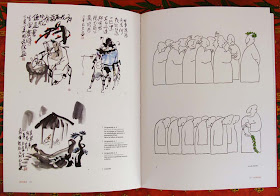
Last week I finished reading
The Brass Ring (Berkley Publishing, 1971, 333 pages), an autobiography written by the American WWII cartoonist Bill Mauldin (1921-2003), in which he tells the story of his childhood and youth untill 1945, the year he won his first
Pulitzer Prize for editorial cartooning. His cartoon characters
Willie and Joe became immortal. The story tells how a poor farm boy became world-famous spokesman for hundreds of thousands of young men at war, the greatest combat cartoonist ever, and won the first of his Pulitzer Prizes , all by the age of 23.
I bought this paperback edition (Berkley Publishing, 1971,333 pages) a few weeks ago for 1,75 euro. I enjoyed reading this books. It's well written, sometimes funny and taking. I learned a lot about the real life of American soldiers and the us army life during the invasion in Italy. I also learned about
V-mail! Nowadays we have e-mail, but back in WWII soldiers could use this kind of Victory-mail. Mauldin drew a successful v-mail Christmas card for the GI's in Italy.
 Mauldins Money-making v-mail christmas card
Mauldins Money-making v-mail christmas card there is a nice story about this cartoon in the book
there is a nice story about this cartoon in the book pre-war cartoons
pre-war cartoonsSome copies out of the book:



Here are some quotations about the book:

" Mauldin's contribution to understanding of the war and how the G.I.s saw it is unique"
(General James M. Gavin)
"If that little son-of-a-bitch sets foot in Third Army I'll throw his ass in jail."
(General George S.Patton)
"For all his often hilarious stories about snafus, high jinks and general military tomfoolery, his prose brings back the feel and smell of war, its pain and loneliness and challenge."
(Newsweek)
A few quotations out of the book I liked:
"General Theodore Roosevelt, junior", she told me. "He got up there and said your cartoons were saying what was on everybody's mind about the way infantrymen get treated in Naples. The other guy said you were inciting mutiny and Roosevelt told him you might be preventing it by blowing off a little steam for the boys" (p. 241)
"Using the survival kids they had been taught, they did some fishing with grenades and found buried wine casks by locating the steel hoops with mine detectors. Unfortunately, I wasn't able to use all of the material I got while hanging around that outfit. It was so wild it defied caricature."
(p.262, about the 1ste Special Forces)
 Mauldin drew this Time cover (June 1945)
Mauldin drew this Time cover (June 1945)"... and General Patton, home for triumphal parades, has said I was the
Bruce Bairnsfather of World War II and that he hadn't liked Bairnsfather, either." (p.331)








 Learn more - go to:
Learn more - go to:







































